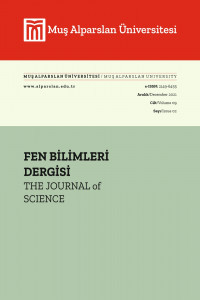A new mathematical approximation for the current density of ionospheric plasma
Current density, conductivity, ionospheric plasma
Iyonosferik plazmanın akım yoğunluğu için yeni bir matematiksel yaklaşım
Akım yoğunluğu, iletkenlik, İyonosferik plazma,
___
- [1] Aydogdu, M. ve Ozcan, O., (1996). Effect of magnetic declination on refractive index and wave polarization coefficients of electromagnetic wave in mid-latitude ionosphere, Indian Journal of radio & space science 25, 263-70.
- [2] Aydogdu, M., Ozcan, O., (2001). The possible effects of the magnetic declination on the wave polarization coefficients at the cutoff point. Progress in Electromagnetic Research, PIER 30, 179–190. Abstract Journal of Electromagnetic Waves and Applications, 14, 1289–1290,
- [3] Aydoǧdu, M., Yeşıl, A., and Güzel, E. (2004). The group refractive indices of HF waves in the ionosphere and departure from the magnitude without collisions. Journal of atmospheric and solar-terrestrial physics, 66(5), 343-348.
- [4] Bittencourt, J. A. (2013). Fundamentals of plasma physics. Springer Science & Business Media.
- [5] Rishbeth, H. ve Garriot, O.K., 1969. Introduction to Ionospheric Physics, Academic Pres, New York, 175-186
- [6] Rishbeth, H., 1973. Physics and Chemistry of The Ionospheric Contemp, Phys, 14,229, 240.
- [7] Sagir, S., Atici, R., Ozcan, O., Yüksel, N. (2015a). The effect of the stratospheric QBO on the neutral density of the D region. Ann.Geophys., 58(3), A0331.
- [8] Sagir, S., Karatay, S., Atici, R., Yesil, A., & Ozcan, O. (2015b). The relationship between the Quasi Biennial Oscillation and Sunspot Number. Advances in Space Research, 55(1), 106-112.
- [9] Sagi, S., Yesil, A., Sanac, G., & Unal, I. (2014). Thecharacterization of diffusion tensor for mid-latitude ionospheric plasma. Annals of Geophysics, 57(2), A0216.
- [10] Yeşil, A., Sağır, S., ve Kurt, K. The Behavior ofthe Classical Diffusion Tensor for Equatorial Ionospheric Plasma. Journal of Science, 13, 123.
- [11] Kurt K., Yeşil A., Sağır S., Atıcı R., 2016: The Relationship of Stratospheric QBO with the Difference of Measured and Calculated NmF2. Acta Geophys. 64, DOI: 10.1515/acgeo-2016-0061.
- [12] Yesil A.,Sagir, S., Ozcan, O., 2009. Comparison of maximum electron density predicted by IRI-2001 with that measured over Chilton station. E-Journal of New World Sci. Acad. 4(3), 92-99.
- ISSN: 2147-7930
- Yayın Aralığı: Yılda 2 Sayı
- Başlangıç: 2013
- Yayıncı: Muş Alparslan Üniversitesi
Hanifi ÇİNİCİ, Uğur GÖKMEN, Görkem KIRMIZI, Ruziye ÇAMKERTEN
A new mathematical approximation for the current density of ionospheric plasma
Bağlayıcı Tipinin Kaplanmış Kağıtların Fiziksel Özelliklerine Etkisi
Arif ÖZCAN, Ömer Bünyamin ZELZELE
Lyapunov Üstelleri İle İris Örüntüsünün Kaotik Yapısının İncelenmesi
Hüsniye Kevser Bayraktar, Özlem Mutlu, Osman Hilmi Koçal
Arduino Devreleri için Kod Üretme ve Veri İşleme Uygulaması Tasarımı
Volkan ÇAVUŞ, Resul TUNA, İsmail Umut DURAN
